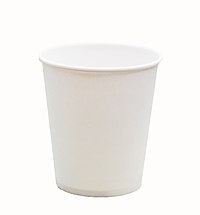종이 컵
역사[편집하다]
Paper cups have been documented in imperial China, where paper was invented by 2nd century BC.[5] Paper cups were known as chih pei and were used for the serving of tea.[6] 다양한 사이즈와 컬러로 제작되었어요, 그리고 장식적인 디자인으로 장식되어 있었어요. 유씨 소유물 설명에 종이컵에 대한 문자적 증거가 등장, from the city of Hangzhou.[6]
현대의 종이컵은 20세기에 개발되었습니다.. 20세기 초, 학교 수도꼭지나 기차의 물통과 같은 수원에서 유리잔이나 국자를 공유하는 것이 일반적이었습니다.. 이러한 공유 사용으로 인해 공중 보건 문제가 발생했습니다.. 그 사용에 대한 주목할만한 조사 중 하나는 Alvin Davison의 연구였습니다., biology professor at Lafayette College, 충격적인 제목으로 출간 “학교에서 마시는 컵의 죽음” in Technical World Magazine in August 1908, based on research carried out in Easton, Pennsylvania‘s public schools. 이 기사는 11월 매사추세츠 주 보건위원회에서 재인쇄 및 배포되었습니다. 1909.[7]
이러한 우려를 바탕으로, 그리고 종이제품으로 (특히 그 이후에는 1908 딕시컵의 발명) 저렴하고 깔끔하게 이용 가능해졌습니다, 공용컵에 대한 지역 금지령이 통과되었습니다. One of the first railway companies to use disposable paper cups was the Lackawanna Railroad, 그것들을 사용하기 시작한 것은 1909. 에 의해 1917, 철도 객차에서 공공 유리가 사라졌습니다., 아직 공공 안경이 금지되지 않은 지역에서도 종이컵으로 교체.[8]
건강상의 이유로 병원에서도 종이컵을 채용하고 있습니다. ~ 안에 1942 매사추세츠 주립 대학은 한 연구에서 세척 가능한 안경을 사용하는 데 드는 비용이, 소독 후 재사용, ~였다 1.6 일회용 종이컵 사용 비용의 몇 배.[9] 이들 연구, 교차 감염 위험도 감소합니다., 병원에서 종이컵 사용을 장려하다.
Dixie cups[편집하다]
Dixie Cup is the brand name for a line of disposable paper cups that were first developed in the United States in 1907 by Lawrence Luellen, a lawyer in Boston, Massachusetts, who was concerned about germs being spread by people sharing glasses or dippers at public supplies of drinking water. Luellen developed an ice-cooled water-vending machine with disposable cups,[7] and with another Bostonian, Hugh Moore, embarked on an advertising campaign to educate the public and to market his machine, principally to railroad companies. Professor Davison’s study was instrumental in abolishing the public glass and opening the door for the paper cup. Soon, the devices, which would dispense cool water for one cent, became standard equipment on trains.
The Dixie Cup was first called “헬스컵”, but from 1919 it was named after a line of dolls made by Alfred Schindler’s Dixie Doll Company in New York. Success led the company, which had existed under a variety of names, to call itself the Dixie Cup Corporation and move to a factory in Wilson, Pennsylvania. Atop the factory was a large water tank in the shape of a cup.[10]
~ 안에 1957, Dixie merged with the American Can Company. The James River Corporation purchased American Can’s paper business in 1982. The assets of James River are now part of Georgia-Pacific, a subsidiary of Koch Industries, the second largest privately owned company in the United States. ~ 안에 1983, production moved to a modern factory in Forks, Pennsylvania. The original factory in Wilson has sat vacant ever since. The closing of the factory also prompted Conrail to abandon the Easton & Northern railroad branch, of which Dixie Cups was the last major customer.
~ 안에 1969, the Dixie Cup logo was created by Saul Bass, a graphic designer known for his motion picture title sequences.
The coupon collector’s problem is sometimes called the Dixie cup problem.
제조[편집하다]

The world’s largest “종이” cup in front of what was once the Lily-Tulip manufacturing company, later Sweetheart Cup Company.[11] Made of poured concrete, the cup stands about 68.1 feet (20.8 m) tall.
The base paper for paper cups are called “컵 보드” and are made on special multi-ply paper machines and have a barrier coating for waterproofing. The paper needs high stiffness and strong wet sizing. The cup board grades have a special design for the cup manufacturing processes. 마우스 롤 성형 공정에는 보드와 플라스틱 코팅의 우수한 신장 특성이 필요합니다.. A well formed mouth roll provides good stiffness and handling properties in the cup. The basis weights of the cup boards are 170–350 g/m2.[12]
위생 요건을 충족하기 위해, 종이컵은 일반적으로 처녀로 제조됩니다. (재활용되지 않는) 재료.[citation needed] The one exception to this rule is when the paper cup features an extra insulating layer for heat retention, 음료와 절대 접촉되지 않는 것, such as a corrugated layer wrapped round a single-wall cup.
방수[편집하다]
원래, 뜨거운 음료를 담는 종이컵은 접착제로 붙인 후 컵 바닥에 소량의 점토를 떨어뜨려 방수 처리했습니다., 그런 다음 점토가 컵 벽을 따라 올라갈 수 있도록 고속으로 회전합니다., 종이에 방수 기능을 부여하다. 하지만, 이로 인해 음료수에서 판지 냄새와 맛이 나게 되었습니다..
차가운 음료수 컵은 같은 방식으로 취급할 수 없습니다., 외부에 결로가 생기기 때문에, 그런 다음 보드에 흡수됩니다., 컵을 불안정하게 만든다. 이 문제를 해결하려면, 컵 제조사는 컵의 안쪽과 바깥쪽에 왁스를 뿌리는 기술을 개발했습니다.. Clay- and wax-coated cups disappeared with the invention of 폴리에틸렌 (PE)-코팅된 컵; 이 공정은 매우 얇은 PE 층으로 보드 표면을 덮습니다., 보드 방수 처리 및 솔기 용접.
종이컵에 인쇄하기[편집하다]
원래 종이컵은 원통에 고무 블록을 장착하여 인쇄되었습니다., 색상마다 다른 원통을 사용하여. 다른 색상에 대한 등록이 매우 어려웠습니다., but later flexography plates became available and with the use of mounting systems it became easier to register across the colours, 더 복잡한 디자인을 허용. 플렉소그래픽 인쇄는 장기간 인쇄에 이상적이며 제조업체는 일반적으로 백만 개가 넘는 컵을 생산할 때 이 방법을 사용합니다.. Machines such as Comexi are used for this, 종이컵 제조업체에서 요구하는 초대형 릴을 수용할 수 있도록 개조되었습니다.. Ink technology has also changed and where solvent-based inks were being used, 대신 수성 잉크가 활용되고 있습니다.. 용제 기반 잉크의 부작용 중 하나는 특히 뜨거운 음료 컵에서 용제 냄새가 날 수 있다는 것입니다., 반면 수성 잉크는 이 문제를 제거했습니다.. Other methods of printing have been used for short runs such as offset printing, which can vary from anything from 10,000 에게 100,000 컵. 오프셋 인쇄 잉크도 개발되었으며 과거에는 용제 기반 잉크였습니다., the latest soya-based inks have reduced the danger of cups smelling. The latest development is Direct-printing, 아주 적은 수량에도 인쇄가 가능합니다., 일반적으로 1,000 컵, and is used by companies including The Paper Cup Company offering small quantities in short lead times. Rotogravure can also be used, 그러나 이것은 매우 비싸며 일반적으로 아이스크림 용기와 같이 매우 높은 품질의 인쇄가 필요한 품목에만 사용됩니다..
Environmental impact[편집하다]
Recycling[편집하다]
Most paper cups are designed for a single use and then disposal. Very little recycled paper is used to make paper cups because of contamination concerns and regulations. Since most paper cups are coated with plastic (폴리에틸렌), then both composting and recycling of paper cups is uncommon because of the difficulty in separating the polyethylene in the recycling process of said cups. As of 2016, there are only two facilities in the UK able to properly recycle PE-coated cups; in the absence of such facilities, the cups are taken to landfill, 또는, at best, incinerated.
A UK-based business group James Cropper have developed the world’s first facility for the effective recycling of the estimated 2.5 billion paper coffee cups used and disposed of by British businesses each year, and have become one of 14 international companies to formally join the Paper Recovery and Recycling Group (PCRRG).
James Cropper’s Reclaimed Fibre Facility was opened by HM The Queen in July 2013, and recovers both the plastic and paper from the cups; ensuring nothing is wasted from the recycling process.[13] Although paper cups are made from renewable resources (wood chips 95% by weight), paper products in a landfill might not decompose, or can release methane, if decomposed anaerobically.
A Newport Beach, CA company, Smart Planet Technologies has developed a process for modifying the polyethylene coating on paper cups and folding cartons so they are engineered for recyclability. Orange Coast College in Costa Mesa, CA has begun a program to use cups made with this technology to capture and sell the fibers to fund scholarships for their students. [14]
The manufacture of paper usually requires inorganic chemicals and creates water effluents. Paper cups may consume more non-renewable resources than cups made of polystyrene foam (whose only significant effluent is pentane).[15][16]
종이 대 플라스틱[편집하다]
에이 life cycle inventory of a comparison of paper vs plastic cups shows environmental effects of both with no clear winner.[17]
폴리에틸렌 (PE) is a petroleum-based coating on paper cups that can slow down the process of biodegrading of the paper it coats.
폴리유산 (PLA) is a biodegradable bio-plastic coating used on some paper cups. PLA is a renewable resource and is certified compostable, 이는 생분해될 때를 의미합니다., 독성 잔류물을 남기지 않습니다..[18] PLA-lined cups are thus the only paper cups which can be composted fully. All paper cups can only be recycled at a specialised treatment facility regardless of the lining.[19]
A number of cities – including Portland, Oregon — have banned XPS foam cups in take-out and fast food restaurants.[20]
Emissions[편집하다]
A study of one paper coffee cup with sleeve (16 ounce) shows that the CO2 emissions is about 0.11 kilograms (0.24 lb) per cup with sleeve – including paper from trees, 재료, production and shipping.[21]
Habitat-loss trees used[편집하다]
The habitat loss from one 16 ounce paper coffee cup with a sleeve is estimated to be 0.09 square meters (0.93 square feet).[dubious ][22][unreliable source?] Over 6.5 million trees were cut down to make 16 billion paper coffee cups used by U.S. in 2006, using 4 billion US gallons (15,000,000 m3) of water and resulting in 253 million pounds (115,000,000 kg) of waste. Overall, US Americans use 58% of all paper cups worldwide, amounting to 130 billion cups.[13][unreliable source?][23][unreliable source?]
뚜껑[편집하다]
종이컵에는 다양한 종류의 뚜껑이 있을 수 있습니다.. The paper cups that are used as containers for yogurt, 예를 들어, 일반적으로 두 가지 유형의 뚜껑이 있습니다.: a plastic press-on, resealable, lid used for large “가족 규모” 컨테이너, 250-1,000ml (8–30 미국 액량 온스), where not all of the yogurt may be consumed at any one time and thus the ability to re-close the container is required and heat-seal foil lids used for small “일인분” 컨테이너, 150–200 ml (5–7 미국 액량 온스).[24]
종이컵으로 판매되는 뜨거운 음료에는 플라스틱 뚜껑이 함께 제공될 수 있습니다., 음료를 뜨겁게 유지하고 쏟아지는 것을 방지하기 위해. These lids have a hole through which the drink can be sipped. 플라스틱 뚜껑에는 필백 탭을 포함한 다양한 기능이 있습니다., 맛있는 뜨거운 음료의 거품과 양각 텍스트를 보호하기 위한 높은 벽.[25] ~ 안에 2008, Starbucks introduced shaped plastic “스플래시 스틱” 구멍을 막으려고, 일부 매장에서는, 고객이 뜨거운 커피가 튀는 것에 대해 불만을 제기한 후.[26][27]
 Feenot 종이컵 기계
Feenot 종이컵 기계





